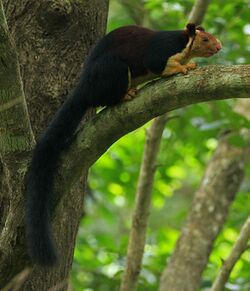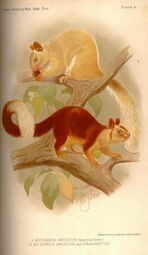Biology:Indian giant squirrel
| Indian giant squirrel | |
|---|---|
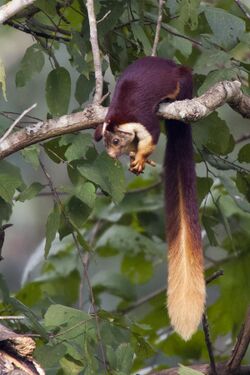
| |
| R. i. indica in Bhadra Wildlife Sanctuary, Karnataka, India | |
| Scientific classification | |
| Domain: | Eukaryota |
| Kingdom: | Animalia |
| Phylum: | Chordata |
| Class: | Mammalia |
| Order: | Rodentia |
| Family: | Sciuridae |
| Genus: | Ratufa |
| Species: | R. indica
|
| Binomial name | |
| Ratufa indica (Erxleben, 1777)
| |
| Subspecies[3] | |
| |
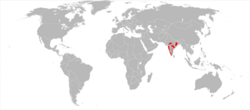
| |
| Indian giant squirrel range | |
The Indian giant squirrel or Malabar giant squirrel (Ratufa indica) is a large multi-coloured tree squirrel species endemic to forests and woodlands in India . It is a diurnal, arboreal, and mainly herbivorous squirrel.[4]
Distribution and habitat
This species is endemic to India, with main sections of its distribution in the Western Ghats, Eastern Ghats and Satpura Range as far north as Madhya Pradesh (approximately 22° N).[1][4] It is found at altitudes of 180–2,300 m (590–7,550 ft) in tropical deciduous, semi-deciduous (where often utilizing denser riparian growth), and moist evergreen forests and woodlands.[1][4][5] In general, its distribution is fragmented because it is intolerant of habitat degradation.[1] The Indian giant squirrel generally nests in taller trees with a mean height of 11 m (36 ft) (±3 m (10 ft) SD) in order to avoid predators.[6]
Description
The Indian giant squirrel is one of the largest squirrels, with a head–and–body length of 25–50 cm (10 in–1 ft 8 in), a tail that is about the same or somewhat longer, and a weight of 1.5–2 kg (3.3–4.4 lb), although rarely up to 3 kg (6.6 lb).[7][8] Average for both sexes is about 36 cm (1 ft 2 in) in head–and–body length, 45 cm (1 ft 6 in) in tail length and 1.7–1.8 kg (3.7–4.0 lb) in weight.[5]
It has a conspicuous one-, two-, or three-toned colour scheme.[9] The colours involved can be whitish, creamy-beige, buff, tan, rust, reddish-maroon, brown, dark seal brown, or black.[5][10] The underparts and the front legs are usually cream coloured, and the head can be brown or beige, and there is a distinctive white spot between the ears.[9] Otherwise the colours depend on the subspecies.[5]
Subspecies
Ten subspecies have been described,[8] but recent authorities generally recognise four:[5][11][1]
- R. i. indica: Found in the northern and central Western Ghats from around Mumbai to Karnataka. Its upper parts and basal half of the tail are rich reddish-maroon or reddish-brown; the distal part of the tail is whitish or buff.[5][8] On occasion there can be some black at the shoulder or at the very base of the tail (features typically associated with other subspecies).[8] A few other subspecies have been described within its range based on variations in size, overall colour hue and width of the pale tail-tip,[8] but recent authorities generally regard them as synonyms of R. i. indica.[3]
- R. i. centralis: From central and eastern India, notably in the Satpura Range and Eastern Ghats (all other subspecies are from the Western Ghats region). It is relatively small and further differs from R. i. indica by its black shoulder region, black tail except for the pale tip, and sometimes black rump.[5][8]
- R. i. dealbata: Found in southern Gujarat (far northern Western Ghats region),[8] but recent surveys have failed to locate it,[1] and it is possibly extinct.[5] A highly distinctive pale subspecies that is overall creamy-buff with a whitish tail and brown ears.[8] It should not be confused with true albinos, rarely recorded in the Indian giant squirrel, which are whiter and have pink eyes unlike R. i. dealbata.[12]
- R. i. maxima: From southern Western Ghats. It resembles a large R. i. centralis, but with more extensive black in the shoulder region and on the rump, and an almost entirely black tail (no pale tip). There is often a black dorsal stripe connecting the black shoulder region and rump. Another subspecies, R. i. bengalensis, has been described from southern Karnataka and northern Kerala, in between R. i. indica and R. i. maxima. It generally resembles R. i. indica, but the tail is black except for its pale tip and sometimes it has black shoulders, thus approaching R. i. maxima or R. i. centralis.[8] Its intermediate appearance and distribution has caused some questions about its validity; it could be regarded as an intergrade and recent authorities often treat it as a synonym of R. i. maxima.[11]
| Subspecies | Authority | Synonyms |
|---|---|---|
| R. i. indica | Erxleben, 1777[13] | bombaya, elphinstoni, purpureus, superans |
| R. i. centralis | Ryley, 1913[14] | none |
| R. i. dealbata | Blanford, 1897 | none |
| R. i. maxima | Schreber, 1784[15] | bengalensis, malabarica |
Behaviour
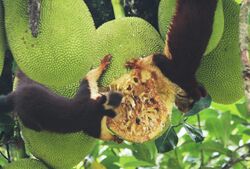
The Indian giant squirrel is an upper-canopy dwelling species, which rarely leaves the trees, and requires "tall profusely branched trees for the construction of nests."[4] It travels from tree to tree with jumps of up to 6 m (20 ft). When in danger, the Indian giant squirrel often freezes or flattens itself against the tree trunk, instead of fleeing.[9] Its main predators are the birds of prey like owls[16] and the leopard.[9] This giant squirrel is mostly active in the early hours of the morning and in the evening, resting in the midday. They are typically solitary animals that only come together for breeding. The species is believed to play a substantial role in shaping the ecosystem of its habitat by engaging in seed dispersal.[17] The diet includes fruit, flowers, nuts and tree bark. They may also eat insects and bird eggs.[18]
Family life
The Indian giant squirrel lives alone or in pairs. They build large globular nests of twigs and leaves, placing them on thinner branches where large predators can't get to them. These nests become conspicuous in deciduous forests during the dry season. An individual may build several nests in a small area of forest which are used as sleeping quarters, with one being used as a nursery.[citation needed]
Reproduction
Captive breeding of the Malayan giant squirrel, a close relative has indicated births in March, April, September and December. The young weigh 74.5 g at birth and have a length of 27.3 cm. In Canara, the Indian Giant Squirrel has been spotted with young in March.[citation needed]
Recognition
The Indian giant squirrel (shekaru in Marathi) is the state animal of the state of Maharashtra in western India.[19]
See also
References
- ↑ 1.0 1.1 1.2 1.3 1.4 1.5 Molur, S. (2016). "Ratufa indica". IUCN Red List of Threatened Species 2016: e.T19378A22262028. doi:10.2305/IUCN.UK.2016-2.RLTS.T19378A22262028.en. https://www.iucnredlist.org/species/19378/22262028. Retrieved 19 November 2021.
- ↑ "Appendices | CITES". https://cites.org/eng/app/appendices.php.
- ↑ 3.0 3.1 3.2 Thorington, R.W. Jr.; Hoffmann, R.S. (2005). "Ratufa indica". in Wilson, D.E.; Reeder, D.M. Mammal Species of the World: A Taxonomic and Geographic Reference (3rd ed.). The Johns Hopkins University Press. pp. 754–818. ISBN 0-8018-8221-4. OCLC 26158608. https://www.departments.bucknell.edu/biology/resources/msw3/browse.asp?id=12400025. Retrieved 21 February 2010.
- ↑ 4.0 4.1 4.2 4.3 (Datta Goyal)
- ↑ 5.0 5.1 5.2 5.3 5.4 5.5 5.6 5.7 Thorington, R.W. Jr.; J.L. Koprowski; M.A. Steele; J.F. Whatton (2012). Squirrels of the World. Baltimore: Johns Hopkins University Press. pp. 26–27. ISBN 978-1-4214-0469-1.
- ↑ Pradhan, A.K.; Shrotriya, S.; Rout, S.D.; Dash, P.K. (2017). "Nesting and feeding habits of the Indian giant squirrel (Ratufa indica) in Karlapat wildlife sanctuary, India". Animal Biodiversity and Conservation 40 (1): 63–69. doi:10.32800/abc.2017.40.0063. http://abc.museucienciesjournals.cat/files/ABC_40-1_pp_63-69.pdf. Retrieved 11 September 2020.
- ↑ Nowak, R.M., ed (1999). Walker's Mammals of the World. 2 (6 ed.). pp. 1274–1275. ISBN 978-0-8018-5789-8.
- ↑ 8.0 8.1 8.2 8.3 8.4 8.5 8.6 8.7 8.8 Abdulali, H.; J.C. Daniel (1952). "Races of the Indian giant squirrel (Ratufa indica)". Journal of the Bombay Natural History Society 50: 469–474.
- ↑ 9.0 9.1 9.2 9.3 Tritsch 2001, pp. 132–133
- ↑ Prater 1971, pp. 24–25
- ↑ 11.0 11.1 Corbet, Gordon Barclay; Hill, John Edwards (1992). The mammals of the Indomalayan Region: a systematic review. Oxford: Oxford University Press. ISBN 0-19-854693-9. OCLC 25281229.
- ↑ Abdulali, H.; J.C. Daniel (1953). "A colour variation, and albinism in the giant squirrel Ratufa indica". The Journal of the Bombay Natural History Society 51: 731.
- ↑ Erxleben, Johann Christian Polykarp (1777) (in la). Systema regni animalis per classes, ordines, genera, species, varietates cum synonymia et historia animalium. Classis I. Mammalia.. 42. Leipzig, Germany: Impensis Weygandianis. OCLC 14843832.
- ↑ Ryley, Kathleen V. (1913). "Scientific results from the mammals survey". Journal of the Bombay Natural History Society (Mumbai, India: Bombay Natural History Society) 22: 434–443. ISSN 0006-6982. OCLC 1536710.
- ↑ Schreber, Johann Christian Daniel von (1792). "Der Springer" (in de). Die Säugthiere in Abbildungen nach der Natur, mit Beschreibungen. 3. Erlangen: Wolfgang Walther. OCLC 16860541.
- ↑ Kannan, R. (1994). Forest Eagle Owl (Bubo nipalensis Hodgson)--a predator of the Indian Giant Squirrel (Ratufa indica). Journal of the Bombay Natural History Society 91: 454
- ↑ Justice, James. "Ratufa indica: Indian Giant Squirrel". http://animaldiversity.org/accounts/Ratufa_indica/.
- ↑ "Indian giant squirrel (Ratufa indica)". Arkive. http://www.arkive.org/indian-giant-squirrel/ratufa-indica/video-08.html.
- ↑ "List of Indian States and their Symbols". 2017-08-14. https://www.jagranjosh.com/general-knowledge/list-of-indian-states-and-their-symbols-1482840512-1.
- Datta, Aparajita; Goyal, S. P. (1996), "Comparison of Forest Structure and Use by the Indian Giant Squirrel (Ratufa indica) in Two Riverine Forests of Central India", Biotropica 28 (3): 394–399, doi:10.2307/2389203
- Prater, S. H. (1971), The book of Indian Animals, Mumbai: Bombay Natural History Society and Oxford University Press. Pp. xxiii, 324, 28 color plates by Paul Barruel., ISBN 0-19-562169-7
- Tritsch, Mark F. (2001), Wildlife of India, London: Harper Collins Publishers. Pp. 192, ISBN 0-00-711062-6
Further reading
- Blanford, W. T. (1897), "The large Indian squirrel (Sciurus indicus Erx.) and its local races and sub-species", Journal of the Bombay Natural History Society 11 (2): 298–305
- Borges, Renee M. (1993), "Figs, Malabar Giant Squirrels, and Fruit Shortages Within Two Tropical Indian Forests", Biotropica 25 (2): 183–190, doi:10.2307/2389182, http://pdfs.semanticscholar.org/19bd/e89931cee405ad3f2d6b2e641f93d756774c.pdf
- Moore, Joseph Curtis (1960), "Squirrel Geography of the Indian Subregion", Systematic Zoology 9 (1): 1–17, doi:10.2307/2411536
- Somanathan, Hema; Mali, Subhash; Borges, Renee M. (2007), "Arboreal larder-hoarding in tropical Indian giant squirrel Ratufa indica", Écoscience 14 (2): 165–169, doi:10.2980/1195-6860(2007)14[165:alitti2.0.co;2]
- Koli, Vijay Kumar; Bhatnagar, Chhaya; Mali, Dilip (2011). "Gliding behaviour of Indian giant flying squirrel Petaurista philippensis Elliot". Current Science 100 (10): 1563–1568.
- Srinivas, V.; Venugopal, P. Dilip; Ram, Sunita (2008). "Site occupancy of the Indian giant squirrel Ratufa indica (Erxleben) in Kalakad–Mundanthurai Tiger Reserve, Tamil Nadu, India". Current Science 95 (7): 889–894.
- Jathanna, Devcharan; Kumar, N. Samba; Karanth, K. Ullas (2008). "Measuring Indian giant squirrel (Ratufa indica) abundance in southern India using distance sampling". Current Science 95 (7): 885–888. http://repository.ias.ac.in/89462/1/23P.pdf.
External links
Wikidata ☰ Q2668978 entry
 |

